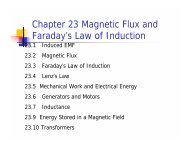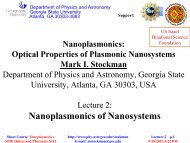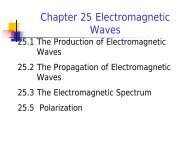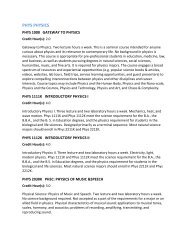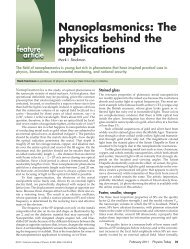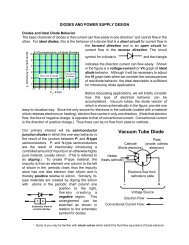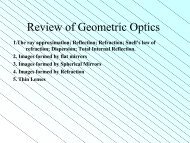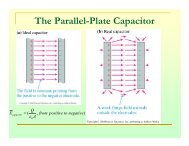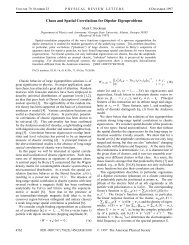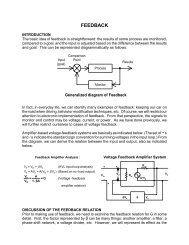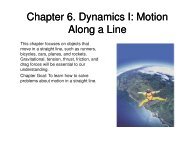Electric Field Electric Field
Electric Field Electric Field
Electric Field Electric Field
Create successful ePaper yourself
Turn your PDF publications into a flip-book with our unique Google optimized e-Paper software.
<strong>Electric</strong> <strong>Field</strong> – Introduction<br />
• The electric force is a field force<br />
• <strong>Field</strong> forces can act through space<br />
The effect is produced even with no physical<br />
contact between objects<br />
• Faraday developed the concept of a field in<br />
terms of electric fields<br />
<strong>Electric</strong> <strong>Field</strong> – Definition<br />
• An electric field is said to exist in the region<br />
of space around a charged object<br />
This charged object is the source charge<br />
• When another charged object, the test<br />
charge, enters this electric field, an electric<br />
force acts on it<br />
1
<strong>Electric</strong> <strong>Field</strong><br />
• The electric field is defined as the electric<br />
force on the test charge per unit charge<br />
• The electric field vector, E, at a point in space<br />
is defined as the electric force F acting on a<br />
positive test charge, q o placed at that point<br />
divided by the test charge: E = F e / q o<br />
<strong>Electric</strong> <strong>Field</strong><br />
• E is the field produced by some charge or charge<br />
distribution, separate from the test charge<br />
• The existence of an electric field is a property of the<br />
source charge<br />
<br />
The presence of the test charge is not necessary for the<br />
field to exist<br />
• The test charge serves as a detector of the field<br />
2
Relationship Between F and E<br />
• F e = qE<br />
<br />
<br />
<br />
This is valid for a point charge only<br />
One of zero size<br />
For larger objects, the field may vary over the size of the<br />
object<br />
• If q is positive, F and E are in the same direction<br />
• If q is negative, F and E are in opposite directions<br />
<strong>Electric</strong> <strong>Field</strong> Notes<br />
• The direction of E is that of<br />
the force on a positive test<br />
charge<br />
• The SI units of E are N/C<br />
• We can also say that an<br />
electric field exists at a<br />
point if a test charge at that<br />
point experiences an<br />
electric force<br />
3
<strong>Electric</strong> <strong>Field</strong>, Vector Form<br />
• Remember Coulomb’s law, between the<br />
source and test charges, can be expressed<br />
as<br />
F<br />
e<br />
qq<br />
= ke<br />
r<br />
o<br />
r ˆ 2<br />
• Then, the electric field will be<br />
E<br />
F<br />
q<br />
e<br />
= =<br />
o<br />
k<br />
e<br />
q<br />
r<br />
r ˆ 2<br />
More About <strong>Electric</strong><br />
<strong>Field</strong> Direction<br />
• a) q is positive, F is directed<br />
away from q<br />
• b) The direction of E is also<br />
away from the positive<br />
source charge<br />
• c) q is negative, F is<br />
directed toward q<br />
• d) E is also toward the<br />
negative source charge<br />
4
Superposition with <strong>Electric</strong><br />
<strong>Field</strong>s<br />
• At any point P, the total electric field due to a<br />
group of source charges equals the vector<br />
sum of electric fields of all the charges<br />
q<br />
E = k<br />
i<br />
e∑<br />
2<br />
r<br />
i<br />
i<br />
rˆ<br />
i<br />
Superposition Example<br />
• Find the electric field due<br />
to q 1 , E 1<br />
• Find the electric field due<br />
to q 2 , E 2<br />
• E = E 1 + E 2<br />
<br />
<br />
Remember, the fields add as<br />
vectors<br />
The direction of the<br />
individual fields is the<br />
direction of the force on a<br />
positive test charge<br />
5
<strong>Electric</strong> <strong>Field</strong> – Continuous<br />
Charge Distribution<br />
• The distances between charges in a group of<br />
charges may be much smaller than the distance<br />
between the group and a point of interest<br />
• In this situation, the system of charges can be<br />
modeled as continuous<br />
• The system of closely spaced charges is equivalent<br />
to a total charge that is continuously distributed<br />
along some line, over some surface, or throughout<br />
some volume<br />
Charge Densities<br />
• Volume charge density: when a charge is<br />
distributed evenly e throughout out a volume<br />
<br />
ρ = Q / V<br />
• Surface charge density: when a charge is<br />
distributed evenly over a surface area<br />
<br />
σ = Q / A<br />
• Linear charge density: when a charge is<br />
distributed along a line<br />
<br />
λ = Q / l<br />
6
<strong>Electric</strong> <strong>Field</strong> Lines<br />
• <strong>Field</strong> lines give us a means of representing the<br />
electric ect c field pictorially<br />
• The electric field vector E is tangent to the electric<br />
field line at each point<br />
<br />
The line has a direction that is the same as that of the<br />
electric field vector<br />
• The number of lines per unit area through a surface<br />
perpendicular p to the lines is proportional p to the<br />
magnitude of the electric field in that region<br />
<strong>Electric</strong> <strong>Field</strong> Lines, General<br />
• The density of lines through<br />
surface A is greater than<br />
through surface B<br />
• The magnitude of the<br />
electric field is greater on<br />
surface A than B<br />
• The lines at different<br />
locations point in different<br />
directions<br />
This indicates the field is<br />
non-uniform<br />
7
<strong>Electric</strong> <strong>Field</strong> Lines, Positive<br />
Point Charge<br />
• The field lines radiate<br />
outward in all directions<br />
In three dimensions, the<br />
distribution is spherical<br />
• The lines are directed away<br />
from the source charge<br />
A positive test charge would<br />
be repelled away from the<br />
positive source charge<br />
<strong>Electric</strong> <strong>Field</strong> Lines, Negative<br />
Point Charge<br />
• The field lines radiate<br />
inward in all directions<br />
• The lines are directed<br />
toward the source charge<br />
A positive test charge<br />
would be attracted<br />
toward the negative<br />
source charge<br />
8
<strong>Electric</strong> <strong>Field</strong> Lines – Dipole<br />
• The charges are equal<br />
and opposite<br />
• The number of field<br />
lines leaving the<br />
positive charge equals<br />
the number of lines<br />
terminating on the<br />
negative charge<br />
<strong>Electric</strong> <strong>Field</strong> Lines – Like<br />
Charges<br />
• The charges are equal<br />
and positive<br />
• The same number of<br />
lines leave each charge<br />
since they are equal in<br />
magnitude<br />
• At a great distance, the<br />
field is approximately<br />
equal to that of a single<br />
charge of 2q<br />
9
<strong>Electric</strong> <strong>Field</strong> Lines<br />
• The positive charge is twice<br />
the magnitude of the<br />
negative charge<br />
• Two lines leave the positive<br />
charge for each line that<br />
terminates on the negative<br />
charge<br />
• At a great distance, the field<br />
would be approximately the<br />
same as that due to a single<br />
charge of +q<br />
<strong>Electric</strong> <strong>Field</strong> Lines – Rules for<br />
Drawing<br />
• The lines must begin on a positive charge and<br />
terminate on a negative charge<br />
<br />
In the case of an excess of one type of charge, some<br />
lines will begin or end infinitely far away<br />
• The number of lines drawn leaving a positive<br />
charge or approaching a negative charge is<br />
proportional to the magnitude of the charge<br />
• No two field lines can cross<br />
10
Parallel Plate Capacitor<br />
Conductors In <strong>Electric</strong> <strong>Field</strong><br />
11
<strong>Electric</strong> Dipole<br />
12



